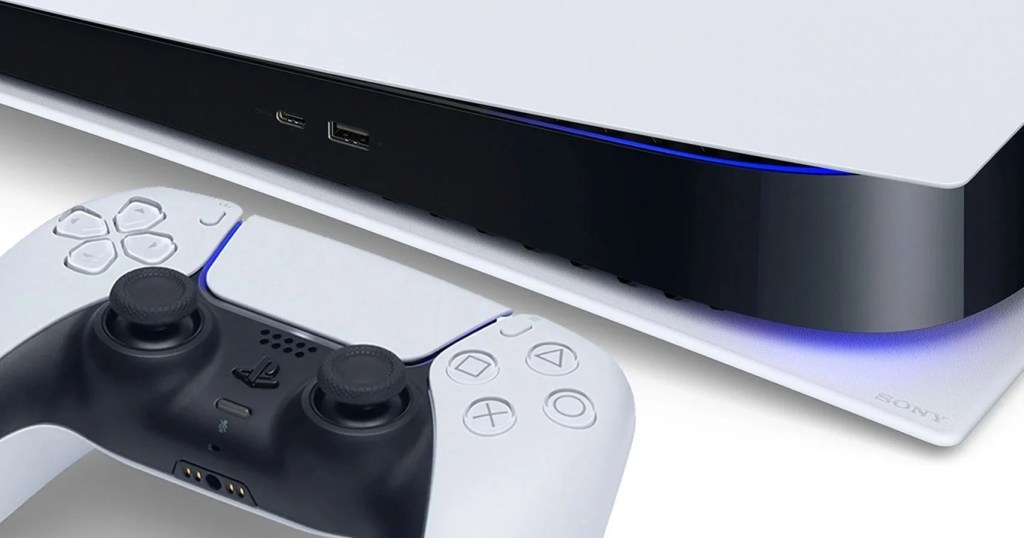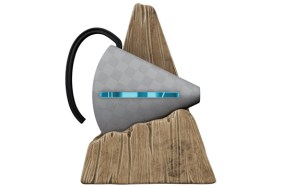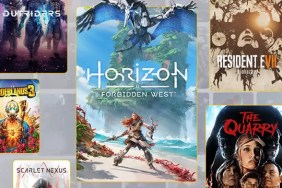It’s a bit hard to believe it’s here. The next generation of consoles. PlayStation 5. Part of that disbelief stems from how relatively subtle the improvements to next-gen are, but taken as a whole this may be the biggest generational leap we’ve ever made, even if it’s not the most obvious. We’ve spent more than a week with the PS5 and it’s clear that Sony has a truly impressive console, once again revolutionizing the experience not just for the players, but for the developers making games.
PS5 Review – Physical Design
We previously talked about the PS5 unboxing experience, a relatively lackluster affair that is focused more on eco-friendly packaging than a premium unboxing. It’s certainly not the prettiest packaging, but it doesn’t matter. Within less than a minute, you’ll have the PS5 out of its box and ready to hook up (or take a whole bunch of pictures of it with stuff).
The PS5 itself is an imposing console, a large size that’s just a bit bigger in person than even pictures can really communicate. Its curved outer faceplates offer something of a flow to the design that makes it appear a bit larger than it is, but it should fit in a good majority of entertainment centers without too many issues. Personally I stopped keeping my consoles inside entertainment centers to allow for better airflow, and the PS5 begs to be kept in view. The lighting design flanking the center curved black piece mimics how the PS4 lighting worked—pulsing between orange, white, and blue lighting depending on what’s happening—but in a much more visually interesting way, reflecting off of the inner portions of the white faceplates. Sure, you aren’t looking at your console while playing it, but it’s a nice touch to just have the system look good.
You can set up the PS5 either horizontally or vertically, both using the included stand. Technically you don’t need the stand. The PS5 sits just fine in both orientations without it. But for that added stability, I’d recommend attaching the stand no matter how you plan to house the system (plus, what else are you going to do with it?). I have mine set up vertically. Attaching the stand was quick and easy—done in less than a minute—and while it did require a screwdriver, it’s a miniscule inconvenience for something that I don’t foresee needing to change, at least anytime in the near future.
Ports on the PS5 have been simplified, removing the optical port for audio and routing all audio through the HDMI connection (or USB, for headsets). This makes setup extremely simple. Plug in the HDMI. Plug in the power cord. Various accessories may need to be connected via USB, but in terms of getting things going, the time from getting the PS5 out of the box to having it running on your TV is mere minutes.
PS5 Review – UX/UI and a Focus on Games
In a lot of ways, the overall experience using the PS5 is familiar, even if it looks quite a bit different. Sony didn’t go and change everything around for no reason, and the changes are evolutions of what’s been built throughout the life of the PS4. Notably, the PS5 UI centers on connecting players with the game, getting them playing quickly, and not bogging them down with a console dashboard as a hub. The PS5 dashboard itself feels almost ancillary, with the new Control Center overlay being the primary place you’ll interact with the PS5 console UI.
The focus on the games is further demonstrated in a UI that eschews custom themes in favor of highlighting the games themselves. Your games become the console theme on the rare occasion you’re actually browsing the dashboard, filling the entire screen with a relevant image and often including musical overtures to go with it. I’ve failed to find anywhere custom themes would even work well given this games-focused approach, which is fine because the UI looks slick as hell.
For existing PS4 owners and people who already have a PSN ID, the setup is nearly instant once you log in. It even pulls over the background image you have set on your PS4 profile screen. Your existing library of PS4 games is there at your fingertips and ready to download or play (more on backwards compatibility with PS4 games below). Trophies populate immediately. The transition doesn’t feel like a full jump to a new console, but a massive evolution of your existing PSN profile. And while it may sound like a negative, that smooth transition is nice. There’s no wasted time here getting set up. I never felt like I was being forced to leave anything behind. The idea is to keep players connected with the PlayStation ecosystem, and Sony made it as easy as it could possibly be.
Most of the little problems I’ve found with the UI have been strictly in muscle memory. Where you had to hold down the PS button on the PS4 to bring up the menu overlay, PS5’s is just a single tap away. Small details like this may take longtime PS4 players some getting used to, but after just over a week with the new console, it has already stopped presenting that issue. Largely, enough of the features and navigation are familiar to how the PS4 did things, so players won’t feel lost. The general settings screen is basically ripped from the PS4 (now with added PS5 specific options), but why change what already works?
Additionally, there are a bunch of great quality of life features included, like the ability to see total game time for each game on your profile, even tracking PS4 games (nearly 3000 hours on Destiny 2, thank you very much). Again, it’s small things that could be perceived as inconsequential on their own, but work in concert to provide what feels like a really big upgrade to a console focused on the player experience, putting games at the center of everything it does.
The biggest step backward I noticed is the inability to create folders or organization of any kind on the dashboard. Games sit in a neat little row, but it’s just a massive line of games, particularly when you bring your PS4 library into the picture. The Media section is separated out from Games, so that element of clutter is cleared up, but I foresee a future update needing to add some kind of better organization system for the dashboard.
Activity Cards are one of the innovations for this console generation, providing what amounts to a bookmark available right in the Control Center overlay. These act as suggestions of sorts, telling you how much of a level or activity you’ve completed, offering hints via videos, and letting you jump right to that spot in the game with next to zero load times. I used these a few times with Astro’s Playroom to find missed collectibles, but never really engaged with them at all in Spider-Man Miles Morales. The idea is still fresh though, and developers may find some novel uses for Activity Cards in the future.
The PS5 UI/UX feels like it was designed to support the games you play, not to be a focus or a platform to play your games on. There’s more of a direct connection between you and what you’re playing, with the PS5’s entire user experience weaving more deeply into the gameplay experience than a console ever has before. The biggest test will be whether or not developers take advantage of these unique aspects of the console and to what degree. Obviously Sony first-party games like Astro’s Playroom and Spider-Man Miles Morales have deep integration, but the sample size at launch is limited so far.
There are still many aspects of the UI/UX we weren’t able to sufficiently test out prior to the official PS5 launch, including PSN account-wide multiplayer accolades as seen on the player profile, the Media section, and jumping right into multiplayer games using the Activity Cards. I’m also looking forward to getting my wife’s PS5 (the one we pre-ordered) and testing a theory I have regarding an option titled “Console Sharing and Offline Play” which I’m pretty certain will fix issues we currently have with the PS4’s whole “Primary console” setting. If it works the way I think it does, it should be a huge boon for households with two PS5s and two users.
I’d also be remiss not to mention the mobile PS App integration, which has notifications when downloads on the PS5 are complete and ready to play. This works for any game downloads, whether its a PS4 or PS5 game, and allows you to start the PS5 and launch the game right from the app. I’m hoping it works for game updates too, letting me know when the latest Destiny 2 update is done so I can hop in. I’m looking forward to seeing how the mobile app’s integration expands in the future.
PS5 Review – Playing the Games, Performance
The PS5 is fast. Blazingly fast. Insanely fast. From startup to gameplay. Fast travel. Level loading. It’s all done within seconds. There’s no more waiting around. I can’t tell you how many times I clicked an option to fast travel in Spider-Man Miles Morales and instinctively picked up my phone during the “loading screen” (a filthy habit, I know), only to find that the game had put me where I wanted to go before I could even turn the screen on. Downtime during games is a thing of the past. Going back to PS4 games is agonizing in comparison, realizing just how much time we’ve wasted on loading screens.
Ray tracing, 4K visuals, and fast consistent framerates are equally as stunning to how a game looks. While they may not offer enormous changes over PS4 games (after all, a lot of launch titles are cross-gen), going from a standard launch PS4 to the PS5 is a visually spectacular experience. With Marvel’s Spider-Man a popular game on the PS4, Miles Morales becomes the flagship kind of experience to show the leap the PS5 makes in how games look and feel. It’s amazing what an accurate reflection from a surface can do for the realism and believability of a game. Subtle, mostly inconsequential (after all, Miles Morales is a cross-gen game available on PS4 too), but a special kind of experience that elevates the visual presentation to a new standard for console gaming.
The PS5 isn’t a magic bullet, however. Personally, in a game like Miles Morales, I opted for the visual fidelity mode over the performance mode. Sure, 60 fps looked smooth and felt great to play, but a solid 30 fps wasn’t a sour experience at all, and the relative tradeoffs to things like ray tracing and overall fidelity of the graphics wasn’t worth the smoother framerate to me.
Of course, sample size of PS5 games at launch is relatively limited, so this is all pretty much based on my experience with Astro’s Playroom and Miles Morales (and perhaps a couple others I can’t quite talk about yet). It will also vary by game, but just knowing what the PS5 is capable of at launch has me excited for all the games to come.
PS5 Review – DualSense Controller
You can’t talk about the PS5 without the experience that is the DualSense controller. Centered on more immersive gaming, the DualSense is aptly named. Haptic feedback allows the controller to convey precise feelings through its variable vibration, both in intensity and location. Adaptive triggers adjust their own tension based on contextual elements within the game. The larger controller size feels good, and offers more surface area for your hand to come into contact with and get the full haptic experience. The DualShock 4 feels comparatively small now.
Astro’s Playroom provides the “ideal” DualSense experience, using its features to almost reckless abandon to demonstrate what’s possible, though Miles Morales has some really neat tricks up its sleeve too. In Astro’s Playroom, every surface and feeling is conveyed through the haptics, from metal to glass to sandstorms to rain to pulling on a stretchy cord. Each one of those feels different. In Miles Morales, thwipping through New York City is accompanied by a slight pressure at the end of the trigger pull to mimic what I must imagine it would feel like to use webshooters for traversal, minus the intense heights.
The DualSense also includes a speaker—much higher quality than the one in the DualShock 4—and a mic, allowing you to chat even if you don’t have a headset (chat audio will come through the DualSense speaker if you aren’t using a headset). A button just below the PS button will mute the mic, but be wary. In multiplayer games you’ll have a hot mic right in your hands. While playing some Destiny 2 and Call of Duty Warzone, I discovered that I’d been speaking via in-game voice chat through the DualSense controller without realizing it. I leave the mic muted by default at all times now to prevent embarrassing (or NDA breaking) hot mic moments.
Battery life is about the same as the DualShock 4, judging by cursory testing, generally giving me between 5-8 hours of active playtime. It charges via USB C, which is nice not having to find which direction the cable plugs in, and Sony’s own DualSense dual charging station ensures you’ll always have a backup ready to go. Overall the battery life isn’t anything amazing, but it also wasn’t so terrible that it ruined my experience. What I’d love to see eventually is a percentage/estimated time remaining for the battery rather than the old “three-bars in a battery icon” to represent how much charge it has. The DualSense can get firmware updates, however, one of which is needed when you first hook up the PS5, so it’s possible we could see added features like this in the future.
PS5 Review – 3D Audio, I Guess
One of the big headline features of the PS5 tech is the Tempest Engine, a system-based 3D audio engine that offers a lot of benefits to developers while giving players a 3D audio experience no matter which headphones they are using. At launch, this feature is still rather limited. It’s only available on headphones, not TV speakers, soundbars, or surround sound setups. When plugging in headphones, the system doesn’t even prompt you to setup the 3D audio profile. Digging through the settings reveals the five different profiles with a test to “choose the one that most closely sounds at ear level.” 1 and 2 were obviously(?) too high for me, but I had a hard time discerning much difference between 3, 4, and 5. And it didn’t really change the 3D audio experience in either Miles Morales or Astro’s Playroom.
The 3D audio still provides a level of dimensionality and texture to any standard pair of headphones that you wouldn’t otherwise get, but I was never really wowed by the Tempest Engine in the way it had been hyped. As Mark Cerny talked about back in March, everyone’s ear profile is different, so a swatch of five default profiles to choose from (and a difficult test to select the right one) is really just ballparking it and not providing the kind of exact measurements each individual player would need to get the best 3D audio experience.
While lacking at launch, I hope this is a feature that continues to be worked on over time, with more in depth options to select the ideal sound profile and really get a unique 3D audio experience matched more closely to each player’s ears.
PS5 Review – PS4 Backwards Compatibility
I’ve long scoffed at backwards compatibility. It was a feature I never really used on previous consoles. But with the advent of digital libraries, online profiles, and ongoing multiplayer games, the line between console generations is much blurrier. Logging into your PSN account on your PS5 immediately has your full PS4 library available to you, ready to download and play. Of course, I have hundreds of games on my PS4, so I didn’t exactly want to eat my bandwidth cap for the month.
Fortunately, external SSDs used with the PS4 are entirely plug-and-play on the PS5. I simply unplugged my 5TB WD_Black P10 Game Drive from my PS4, plugged it into the USB port on the back of the PS5, and my entire library was immediately available to play. There was no setup required, no formatting, and no need to wait while all my games transferred or downloaded. From here I booted up Destiny 2 and Call of Duty Warzone, smirking as the people I was playing with had no idea I was on a PS5.
The PS5 will also default to downloading PS4 games onto the external hard drive to save that precious SSD space for PS5 games that need it (more on that below). So when I redeemed my review codes for Fuser and Assassin’s Creed Valhalla, those were pushed to the external hard drive and then I was able to play them without issue on the PS5.
In terms of performance, it’s hard to notice a significant boost for PS4 games at a glance, particularly when compared with the stellar performance of the native PS5 games. I was still loading these games off of a standard hard drive, still limited by other players ‘loading and matchmaking in multiplayer games, and any boosts available mimicked the PS4 Pro boosts (which admittedly, I hadn’t ever experienced for myself). In that respect they did look better and tightened up some load times compared to trying to run them off of my old launch PS4. Installing PS4 games directly on the SSD does offer some additional small advantages on a title by title basis, but for the most part, meaningful enhancements will require updates from the developer or a native PS5 version of the game. Long story short, don’t expect PS4 backwards compatibility on the PS5 to radically change the last-gen gaming experience, though it does give it a nice little polish.
PS5 Review – SSD Storage
The PS5 SSD houses a paltry 667.2GB of usable storage space. With the limited launch lineup I’ve been reviewing (and relegating all PS4 games to an external drive), I’ve already used up nearly half of the available space. Games like Call of Duty Black Ops Cold War require 133GB for the full install (though pieces can be uninstalled if you don’t need them). I foresee starting to bump up against this cap before the end of the year, if not before the month is out.
SSD storage expansion options aren’t available immediately at launch, “reserved for a future update” according to Sony, but the limited space is quickly going to become an issue for many players if game sizes trend in the 50-100GB range. This isn’t helped by the default setting that takes 15-second Trophy videos for every Trophy earned, further eating into storage space on the console.
Eventually, players will have the opportunity to load third-party M.2 SSDs into a storage bay located under the PS5’s removable outer shell. It’s a bit more intensive than Microsoft’s simple proprietary expansion slot, but should ultimately be cheaper for PS5 players, as well as offering them a bit more freedom and choice for what SSD storage expansion options to use. As of launch, however, 667.2GB is all you get.
PS5 Review – Fan Noise, or the Lack Thereof
Begone ye jet engine consoles of old. The PS5 is whisper silent. In fact, to actually hear the sound of the fan, I had to walk up to the console and put my ear beside it. Gone are the days of the fan ramping up during intensive games thanks to the PS5’s optimized consistent power consumption (though admittedly there have been few games to actually test this out with yet). Ultimately, the PS5 fan noise is negligible, if even noticeable at all, depending on your sound setup and the ambient noise of the room you’re in. Finally, play your games without background white noise from the fan to keep you company.
PS5 Review – A Meaningful Evolution of the Gaming Experience
The PS5 is a callback to the original PlayStation; namely in Sony’s determination to make a console both for the developers and the players. The fundamental engineering and architecture of the PS5 system is entirely to offer more freedom to developers, which in turn provides a better gaming experience for the players. While it’s an impressive piece of hardware, it’s now up to the developers to utilize it, and I can’t wait to see the kinds of experiences we get from Sony’s first-party studios like Naughty Dog and Sony Santa Monica.
On the surface, the player-facing evolution to the PS5 may seem like a smaller generational leap than past console launches, but it’s all in the player experience. The new console is no longer all about just pushing games to do things that weren’t possible last gen (though there certainly is that thanks to the SSD enabling entirely new game design fundamentals). PlayStation 5 changes what it feels like to play games, from the physical feeling in your hands to blink-and-you’ll-miss-it loading times and subtle but stunning elements like ray tracing. The platform engages with the games at a fundamental level that feels less like a thing you play games on and more like a thing you play games with. Sony didn’t just say “how can we make games bigger, faster, and prettier,” but asked themselves “how can we meaningfully evolve the gaming experience?” The answer is the PlayStation 5.
PlayStation 5 review console provided by Sony. For more information, please read our Review Policy.
This is just our early PS5 coverage. Stay tuned as we continue covering the PS5 through and beyond the November 12th launch, including features that we couldn’t properly test or engage with prior to the wide release of the console. There are plenty of details we haven’t talked about much here (like community, sharing, Trophies, etc.) that we felt either weren’t fundamental to the console’s core experience or we didn’t get enough time with to properly talk about yet. Expect to hear more about those soon.















